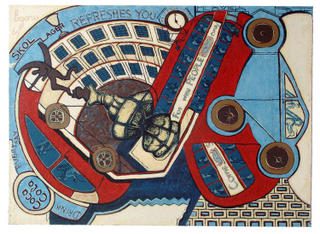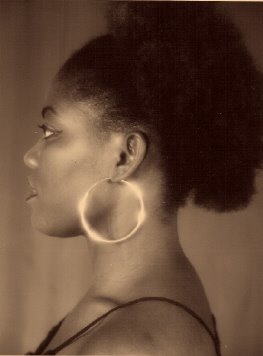Uzo Egonu's Vision of London

Uzo Egonu's Vision of London
By Molara Wood
By the time of his death in 1996, the Onitsha-born artist, Uzo Egonu, had lived in London for 50 years. This long association proved to be an important one for both the artist and the city, and London was to emerge as a major presence in Egonu's works. Throughout a successful international career, he helped capture the many faces of London as seen through his unique artistic eye. And now, the city returns the compliment with the first major exhibition since his death, Uzo Egonu’s London. Currently on show at the Museum of London, the exhibition celebrates the artist's bold vision of his adopted city.
The Museum of London is located right in the heart of the city and provides the perfect setting for exhibiting an artist whose work draws an imaginative map of the city. Coming out of the Museum and heading towards one of the nearby tube stations, the historic St Paul’s Cathedral is prominent in the skyline, overlooking Greater London as it has done for centuries. From there, it is possible to embark on the ‘Egonu walk’ of London; a location map of the city as visualised by the artist accompanies the exhibition.

St Paul’s Cathedral, painted by the artist in 1965, was the first in a series of famous London landmarks given the Egonu treatment during the sixties. Westminster Abbey (1966) and Tower Bridge (1969) were to follow. His painting of Trafalgar Square (1968) shows the hallmarks of the world-famous site: the lion statues, fountains, and South Africa House. The piece also shows pigeons, once synonymous with the square, but now banished from the site by current Mayor Ken Livingstone.
The works are rendered in fresh, bold colours, blending representation and abstraction, caricature and photo-realism; incorporating varied traditions including cubism, Nigerian ornamentation and the contemporary British pop-art of the artist's time.
Uzo Egonu’s study of Piccadilly Circus, painted in 1966, combines of all these elements and marked the beginning of the style of painting for which the artist has become famous. Like others in the ‘landmark’ series, Piccadilly Circus symbolises both the spiritual and commercial aspects of London with pathos and humour. The statue of Eros which stands high above the busy Piccadilly Circus traffic, is shown in the cubist style, and represents the hub around which all else in the vicinity spins. Brand names, a red double-decker bus, advertising slogans and buildings - all revolve around Eros in a three-hue harmony of white, blue and red.
As displayed in the Museum of London exhibition, the landmark paintings show the sacred and profane aspects of the city in kaleidoscopic patterning, combining the symbolic and the playful. The European modernist elements of the series, with their bird’s eye view over London and the circular compositions, are in fact characteristic of Igbo artistic traditions. Egonu’s work merged European and Igbo traditions but more significantly, placed Africa as the touchstone of modernism. In combining the visual languages of Western and African art, he helped redefine the boundaries of modernism, thereby challenging the European myth of the naïve, primitive African artist.
Described as a master of metaphor, Egonu was a child prodigy whose artistic talent was spotted early by his father, who sent him to England at the age of thirteen in 1945. The early separation from his parents and homeland left the artist with a deep nostalgia for the land, the people and its folklore. A picture, taken in Egonu’s West Hampstead studio in 1964, shows him surrounded by works depicting images of his lost homeland.
The condition of exile, alienation and the pain of displaced peoples would be a recurrent theme throughout Egonu’s career. His exploration of these themes was often overarching and universal, encompassing not only physical or geographical displacement, but societal displacement as well. Two works from 1988, Tears of Sorrow and Strangers in Their Own Land, can be seen in the exhibition and explore the human condition not just in relation to immigrants, but native Londoners as well. They are regarded as studies in social exclusion - a real experience for many who live in the urban setting but are alienated from it for reasons outside their control.
The impact of the Biafran War on Egonu also came through in his work. Exodus (1970) explored the consequences of global conflict, and reflected the artist’s agony over events in Nigeria. The exodus continues apace today and is evident in London's multi-cultural mix. The isolation of the dispossessed, whether as a result of migration or social exclusion, is also the subject of a series of screenprints including Lone Eater, on display in the exhibition. They are studies of Londoners relaxing in their own space, often depicted as lonely, alienated people. Among these, the award-winning A Cup of Coffee in Solitude, is one of Egonu’s most famous prints. It was adopted by the Charity Oxfam as the promotional image for its Art for a Fairer World Initiative.
Uzo Egonu studied at the Camberwell School of Fine Arts and Crafts, and St Martin’s School of Art in the 1950’s. Later, in 1970, he attended the Working Men’s College in London’s Camden Town to update his printmaking techniques. The Working Men’s College, as a community of artists, placed much importance on debating the social issues of the day, a concern that also reflected in Egonu’s work. He engaged with the burdens of urban living in Addictions, a series of lithographs exploring gambling, drug abuse, smoking and binge-eating. Three pieces from the series form part of Uzo Egonu’s London.
Another lithograph, Traffic, predicted the gridlocked London of the future, a crisis that has seen congestion charges instituted to discourage cars coming into the centre of the city during the day.
With failing health and encroaching blindness in the 1980s, Uzo Egonu compensated for his dimmed sight with an even bolder use of colour. His Landcape paintings from this period represent an almost surreal vision shot through with hidden meanings. He also took on celebratory, epic themes, with pieces like Record Breakers (1993), commenting on British technological advancement in transport.
Whether focussing on its landmarks, people or issues, Uzo Egonu gave visual life to London in all its hope, decline, and grandeur. For this, he is remembered as an artist who helped reinterpret the city as a truly international centre, capturing its true essence whilst giving it an African flavour.
Egonu’s work is on display in public collections all over the world. The International Association of Art admitted him into the league of life counsellors in 1983; an honour that placed him in the same league as Western artists like John Miro and Pablo Picasso.
Curated by Susan Okokon, Uzo Egonu’s London opened on September 23 as part of ongoing black history events at the Museum of London. The exhibition is on display until January 9.
- Published in The Guardian, Lagos, on 19 December 2004.


0 Comments:
Post a Comment
<< Home